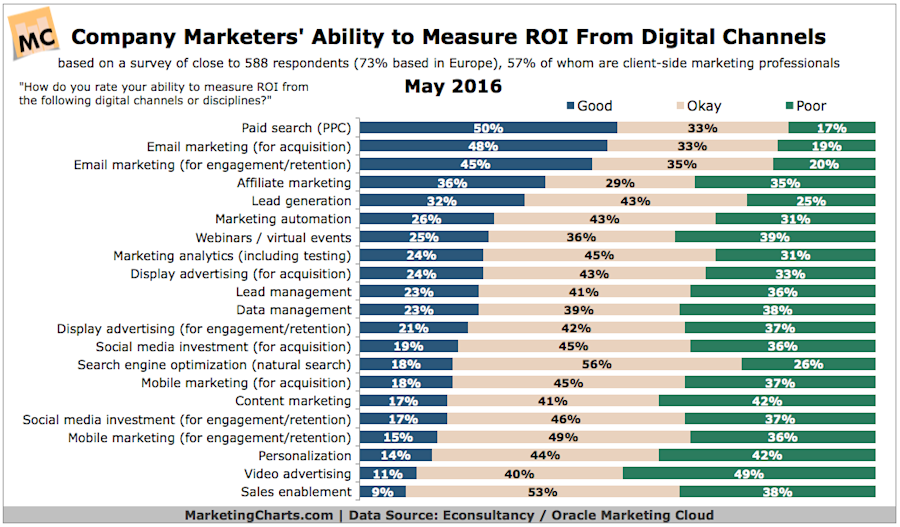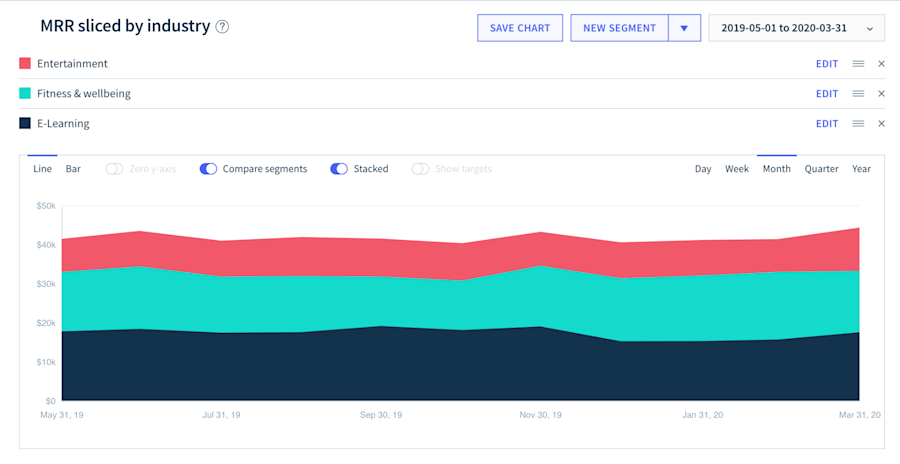Spend 5 minutes online, and you can find an innumerable amount of charts and graphics that compare the ROI of various marketing channels.
Like this:

And this one:

And maybe even this one:

What is suspiciously common about all these is that they always prescribe a magical solution: a channel — sometimes related to the service the brand is selling — that’s better than anything else out there.
Maybe a one-size-fits-all channel would be a good solution in a world of one-size-fits-all businesses, but why would anyone claim it works in our world where every business is so different?
That’s why we believe that instead of relying on the honest word of internet influencers and self-proclaimed marketing ninjas, you should find out what is the best marketing channel for your business.
I can already hear you say “But I don’t have the time/money/audience to run surveys and perform complicated statistical analysis!”
You don’t need to!
Everything you need to answer these questions for your own business is already here — in the data your business generates every day.
Website visits. Micro conversions. Trials started. Product usage. Subscriptions. Payments.
In this article, I want to show you how you can use your customer and buyer intent data to find out what are the best channels for your business.
What is buyer intent data?
Buyer intent data is every piece of information that’s telling you that a certain person is likely to become a customer.
Requesting a demo or starting a trial are the most obvious examples. However, depending on your business and marketing models, many additional actions can fall under this category — visiting your pricing page, downloading a specific piece of content like a product comparison list, etc.
In its essence, buyer intent comes down to performing a specific action, which has two essential parameters: WHO is doing the action, and WHAT the action is.
Finding your own definition of buyer intent is imperative for making good use of the data you have. In the following sections, I want to give you an idea of how you can do that and harness that data to grow your business.
How to capture buyer intent
As we outlined above, you need two essential pieces of data to capture buyer intent — you need to know WHO the buyer is and WHAT are the actions that signify they are likely to become a customer.
Leadfeeder allows you to capture both of those essential data points:

It gives you both data on the organization and information about the specific person from the target company who’s visiting your website.
In addition, it tells you what pages they’re browsing.
You don’t need to stop there — you can add any additional data points about demographics or the behavior of trial users in your product.
G2 has a useful resource on tools that deal with buyer intent.
Using Zapier or a similar tool, you can then collect all this data into one place — usually your CRM or your subscription data platform and use it further.
Capturing buyer intent is great, but it’s not the end. In the next sections, I want to show you some ways in which you can use this data to find specific opportunities to grow your business.
How to analyze buyer intent
Using a subscription data platform allows you to find answers to all sorts of questions.
Inferring buyer intent from demographic data
Maybe you’re wondering whether customers from a particular industry or of a particular size are a better fit for your product.
Segment your customers on the basis of the niche they operate in and review their key metrics.

Which group is the biggest contributor to your revenue? Where is retention the highest? Which group has the highest LTV?
Repeating this type of analysis across various dimensions (industry, size, etc.) allows you to build a profile of the best type of customer.
You can then go back to your buyer intent tools and set them up in a way that identifies and gives priority to leads who possess those attributes.
Here is an example of what this looks like in Pipedrive.
Understanding the behavior that drives conversions
You can perform a similar analysis to understand what are the actions that guarantee the highest probability that a prospect becomes a long-term loyal customer.
Let’s say you’re making a big bet on a particular piece of content. You believe that you can educate your prospects through it and:
a) make them more likely to become customers; b) keep them for longer.
There are various ways, which you can use to record this kind of data. It can be recorded as an event in Google Analytics or as a custom parameter in your CRM tool.
You can then import this data into your subscription data platform and record it as a custom attribute.
In our example, we’ll use a company like Netflix — let’s say they want to analyze whether a new show has a beneficial effect on customer retention:

Now, all you have to do is segment your customers based on this data point and try to get answers to the questions we asked above.

For example, are they converting at a higher rate than regular trials?
Or does binging on political drama makes them less likely to churn in a given month:

This is the power your data — whether it’s coming from your website visits or from the invoices you’ve issues — it allows you to find growth levers for your business.
Use buyer intent to make smart decisions
To figure out the best marketing channels for your business, you have to find out the unique mix of factors that affect you.
There’s no better place to learn than your own customers. Talking to each of them is time-consuming at best and most likely impossible beyond a certain point (when you have more than a thousand for example).
The second best way to do it (as scale!) is to use your data.
You might feel overwhelmed at first. Keep in mind that it’s ok to start small.
Tools like Leadfeeder and ChartMogul allow you to scale your efforts without throwing people or complexity at them.
More leads, no forms.
Sounds too good to be true? It’s not. Identify companies already visiting your website and turn them into qualified leads to fuel your sales pipeline.
Show me how







